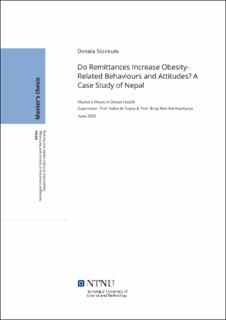| dc.description.abstract | Background: Developing countries have entered the stage of dietary and physical activity transition led by a phenomenal economic growth in recent years. It is reasonable to make an inference that the answer lies in socioeconomic changes over the years. Changes in nutrition and physical activity, that derive from increasing household income, become an emerging health hazard.
Objectives: To examine the relationship between remittances and non-communicable disease-related health behaviours and attitudes of the Nepali youth, with a focus on nutritional consumption and physical activity. Nepal provides a unique case study due to the country’s changes in financial structures with increasing remittances per capita, in societal structures and the rapid development of infrastructures.
Methods: Time-Series Cross-Sectional data from the Global Burden of Disease Study and the World Bank was analyzed to give a global perspective. An individual-level data in Nepal was collected employing a community-based survey questionnaire.
Results: The findings from the macro-data analysis show that both on a global scale and within the least developed countries, remittances have a significant but very small negative effect on the prevalence of obesity among the youth. In support of these findings, survey data revealed that remittances were positively associated with physical activity levels in the studied population. However, findings from the analysis of behaviours and attitudes contradict this theory. Remittance receivers report caring about and participating in sport activities less frequently compared to non-receivers. The analysis of the relationship between remittances and BMI did not arrive at conclusive statistical evidence.
Conclusions: There is not enough evidence to indicate that the remittances are driving the increasing obesity rates. There is some suggestion of promotive health effects of remittances, but these effects are small and inconclusive. Further research should be focusing on cumulative effects of migration proxies rather than an individual effect of remittances. | |
